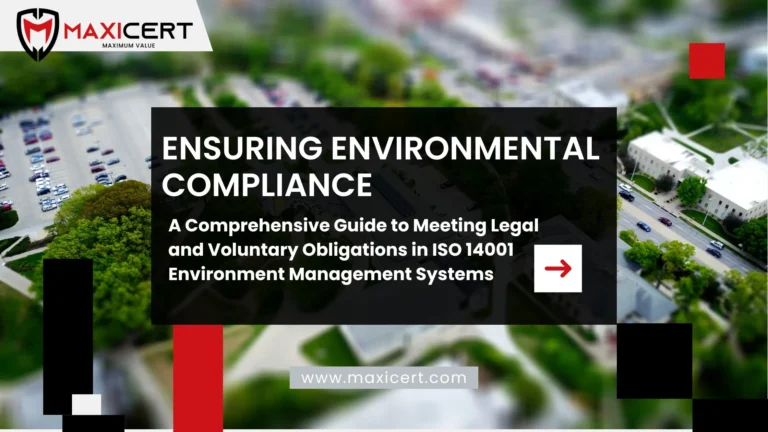Ensuring Environmental Compliance: A Comprehensive Guide to Meeting Legal and Voluntary Obligations in ISO 14001 Environment Management Systems

Introduction
Environmental compliance is a cornerstone of sustainable business practices. This guide explores how organizations can identify, understand, and fulfill their compliance obligations, including legal requirements and voluntary commitments, as required by ISO 14001 environmental certification. Learn how to integrate these obligations into your Environmental Management System (EMS), mitigate risks, and enhance your organization’s environmental performance.
Discover actionable steps to stay ahead of regulatory changes, meet ISO 14001 standards, and strengthen your sustainability efforts.
For expert guidance and certification support, trust Maxicert – the best ISO consultants for ISO 14001 implementation and environmental compliance success.
Compliance obligations
The organization determines, at a sufficiently detailed level, the compliance obligations it identified, that are applicable to its environmental aspects and how they apply to the organization. Compliance obligations include legal requirements that an organization has to comply with and other requirements that the organization has to or chooses to comply with.
Request A Free Quote
General
Compliance obligations can result in risks and opportunities that need to be addressed. Identifying and having access to compliance obligations and understanding how they apply to the organization is the first stage in ensuring fulfilment of compliance obligations. Using the knowledge gained, the organization should establish, implement and maintain a process to identify and have access to compliance obligations that are related to the environmental aspects of its activities, products and services. This process should enable the organization to consider and prepare for new or changing needs and expectations from interested parties, so that preparatory action can be taken, as appropriate, to maintain conformity. The organization should also consider how planned or new developments and new or modified activities, products and services could affect its compliance status.
An organization should ensure that appropriate information about compliance obligations communicated to persons working under the organization’s control (including external providers, such as contractors or suppliers) whose responsibilities relate to, or whose ache can affect, fulfillment of compliance obligations.
Legal requirements
An organization can access one or more information sources as a means to identify legal requirements related to its environmental aspects. Such sources can include governmental regulatory agencies, industry associations, or trade groups, commercial databases and publications, and professional advisors and services. The process should enable the organization to anticipate and prepare for new or changed legal requirements, so that it can maintain conformity.
Mandatory legal requirements related to an organization’s environmental aspects can include if applicable:
- Requirements from governmental entities or other relevant authorities.
- International, national and local laws and regulations.
- Requirements specified in permits, licenses or other forms of authorization.
- Orders, rules or guidance from regulatory agencies.
- Judgements of courts or administrative tribunals.
Other requirements
An organization should also determine how other compliance obligations it has adopted, originating from other interested parties as identified, relate to the organization’s environmental aspects. These can include, if applicable:
- Agreements with community groups or non-governmental organizations.
- Agreements with public authorities or customers.
- Organizational requirements.
- Voluntary principles or codes of practice.
- Voluntary labeling or environmental commitments.
- Obligations arising under contractual arrangements with the organization.
- Relevant organizational or industry standards.
Compliance obligations—practical help:
The recommended components of the environmental management system related to compliance obligations are summarized in the following list. An organization should establish, implement and maintain processes needed and provide adequate resources to:
- Establish an environmental policy that includes a commitment to fulfil compliance obligations.
- Identify, have access to, and understand how these compliance obligations apply to the organization.
- Establish environmental objectives with consideration of compliance obligations.
- Achieve environmental objectives related to compliance obligations through:
Identified roles, responsibilities, processes, means, and timeframes to achieve environmental objectives related to the fulfillment of compliance obligations.
Operational controls (including procedures, as necessary) to implement the commitment to compliance and environmental objectives related to compliance obligations.
- Ensure that all persons working under the organization’s control are aware of related processes that apply to them, and the consequences of failing to fulfil compliance obligations.
- Ensure that all persons working under the organization’s control have the necessary competence regarding applicable compliance obligations, related processes that apply to them, and the importance of fulfilling applicable compliance obligations, on the basis of appropriate education, training, or experience.
- Establish processes for communication relevant to the environmental management system, taking into account the organization’s compliance obligations.
- Periodically evaluate fulfilment of compliance obligations.
- Identify any instances of non-compliance or non-conformity and take prompt action to identify, implement and follow up corrective actions.
- Retain documented information of results of its evaluation of compliance.
- Address features related to fulfilment of compliance obligations when conducting periodic audits of the environmental management system.
- Consider changes in compliance obligations when undertaking the management review.
The commitment to fulfilment of compliance obligations reflects an expectation that an organization employs a systematic approach to achieve and maintain fulfilment of compliance obligations.
Conclusion
Compliance obligations are critical to an organization’s Environmental Management System (EMS). By identifying, understanding, and integrating legal requirements and voluntary commitments into operations, organizations can mitigate environmental risks, improve environmental performance, and maintain ISO 14001 environmental compliance. A proactive approach ensures adaptability to new regulations and strengthens long-term sustainability commitments.
Need expert support for ISO 14001 certification? Visit Maxicert – the best ISO consultants to get professional guidance and achieve full compliance with international standards.

Get In Touch

Get In Touch

Get In Touch
Need A Free Estimate?
Get a free consultation and Checklist to get certified for ISO , HALAL, CE Mark Certification.
FAQ
What are compliance obligations in environmental management?
Compliance obligations include legal requirements (laws, permits) and voluntary commitments (industry codes, agreements) that an organization must or chooses to follow.
Why is periodic evaluation of compliance obligations important?
Regular assessments help organizations stay aligned with evolving regulations, address non-conformities and improve environmental performance.
How can organizations ensure employees comply with environmental regulations?
Through training, clear communication of compliance-related responsibilities and implementing operational controls to enforce adherence.



